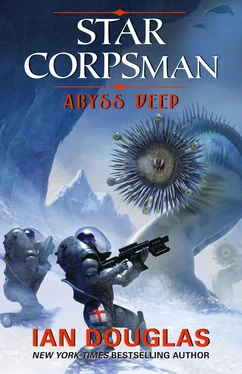I looked at Kirchner with curiosity. He was a small older man with an intense gaze that made me uncomfortable. If he was from SAMMC, though, he would be good. I wondered about his age, though. His white hair was thickly interspersed with black, and his face, with deep-set wrinkles, was an odd mixture of weathered skin and baby-pink new.
Anagathic treatments. He was under treatment for that most deadly of the diseases to afflict Humankind—old age.
“Dr. Kirchner,” Garner continued, “was chief of the xenopathology department at Sam-Sea, so he will be our expedition xenologist as well as ship’s doctor. We’re very lucky to have him on board.”
And that was a relief. I’d been wondering since Singer had told me I was being assigned to this mission whether we’d have a medical officer on board. I knew that Garner was IDC, but none of the rest of us were.
Independent-duty Corpsmen were the medical department on ships or bases too small to have a ship’s doctor, and that was a hellacious responsibility. Oh, we operated independently in the field as often as not … but it was always good to have a real doctor backing you up.
You know, even today, we still hear the story of an independent-duty Corpsman during the Second World War—we were called Pharmacy Mates in those days—who successfully performed an appendectomy while on board a submarine, the USS Seadragon, while she was on her fourth war patrol, in 1942. He was twenty-three-year-old PhM1/c Wheeler B. Lipes—a first class, like McKean.
In fact, though it’s not well known, there were three emergency appendectomies carried out by Pharmacy Mates on board Navy submarines during that war, this when the only commonly available antibiotics were powdered sulfanilamide and phenol, and the only anesthetic was ether. My God! The responsibility those guys faced was staggering! But, damn it, when there were no qualified surgeons within a thousand miles, you did what you had to do… .
Kirchner stood and acknowledged Garner’s introduction. “Thank you, Chief.” He glared at us. “No speeches, people. I know you’re well trained, I know you’re experienced, and I know you’re going to do your jobs competently and well. With pre-screening of the ship’s complement, we shouldn’t have any major health issues, and Haldane’s medical department will be able to focus on the tech support at GJ 1214. So do your jobs, do what you’re told, and we’ll all get along just fine. Chief Garner?”
“Thank you, sir.” Garner turned to face us again. “Okay, I want all of you to pull down the Abyss Deep docuinteractive from the Clymer’s library. On your own time.”
“Aw, Chief,” Dubois said. “What for? The place is nothing but a freaking ice ball.” He’d been angry ever since his orders had come down telling him he was deploying to Abyss Deep, and he didn’t mind letting everyone else within range know it.
“Can the gripeload, Doobie. That goddamn bleak ball of ice can kill you faster and in more ways than a Qesh Daitya platform.”
McKean and Harris both grumbled a bit, too, and, I have to admit, I did as well. Sailors hate having official shit intrude on their precious downtime, and I already had the extra duty tagged onto my daily schedule by my NJP. But as the ancient adage has it, a griping sailor is a happy sailor. Garner had scored a point by bringing up the Daityas, heavy-weapons platforms named for a class of giant or demon in Hindu mythology. We’d faced Qesh Daityas out on Bloodworld, and had a healthy respect for the things.
“Okay,” Garner went on, “we’re slated to board the Haldane tomorrow evening. Our civilian … guests will be joining us on board. They are Dr. Carla Montgomery and Dr. Raúl Ortega. Montgomery is an expert on exobiology. Ortega is an expert on planets and environments with extreme temperatures or other exotic conditions.
“We have absolutely no idea what happened to Murdock Base. None. The last report from there, via robot courier, mentioned sightings of the autochthones, the native life, but no contact … and no danger. The next courier was due from them four days later. It’s been three weeks, now, with no word from them whatsoever. We must assume that the base has suffered some significant problem. It may be as minor as a failure in the AIs they use to launch and transmit to the couriers. Or it may be more serious. A lot more serious.
“So they’re sending in the Marines. And us.”
More download information flooded through our in-heads, a schematic view of a multilevel dome equipped with living quarters, common areas, airlocks, and a large central laboratory space.
“The base,” Garner went on, “is a standard nano-grown all-climate dome, with several outlying structures … but only the main dome is pressurized. The colony consists of eighty-five men and women—mostly science staff, but including admin and support—plus twelve M’nangat in four family triads. The M’nangat are there to liaise with the EG, if need be, in order to conduct deep research on any locals that they might manage to contact.”
The Brocs had become more and more important as we researched the labyrinth of data that was the Encyclopedia Galactica. Our best guess right now is that we have been able to access something less than one hundredth of 1 percent of the EG data that’s out there, and we wouldn’t have been able to tap that much if not for M’nangat help. If the organisms discovered on GJ 1214 I were intelligent—and that was by no means certain yet—there ought to be a listing and a lot more data available on the local EG nodes.
As yet we could find nothing, but that didn’t mean it wasn’t there. There are an estimated 50 to 100 million intelligent species scattered through our Galaxy, and perhaps a thousand times that number that have existed during the past billion years, but which now are extinct. Many, though by no means all, of these have entries in the EG. Technic species that discover the EG and learn how to tap in, sometimes, though not always, list themselves. Atechnic species—marine organisms that have never discovered fire and metal smelting, for instance—or the more inwardly focused species who have turned their backs on space travel are often described by others who encounter them.
For a billion years—as long as multicellular life has existed on Earth—the Encyclopedia Galactica has grown in both size and complexity, with millions of separate channels, nested frequencies, and deep-heterodyned polylogues. Lots of channels we can’t even access yet; we’re certain there are neutrino channels, for instance, but we don’t know how to read them. When we discovered the local node at Sirius, just 8.6 light years from Earth, we swiftly decided that we needed friendly native guides to lead us through the data jungles.
We would have copies of small parts of the EG with us at GJ 1214, as much as could be accommodated by the Haldane’s sizeable quantum computer storage. We’re still working out how the EG is organized, but we think it includes data on all nearby stars in the direction of the constellation Ophiuchus, which is where GJ 1214 is located in the night sky. With luck, we’d scooped up the still-hidden entry on Abyssworld along with known nearby stars in that region—70 and 36 Ophiuchi, Sabik, Raselhague, and others—and our AIs could be hacking through the jungle while we worked.
Eventually the briefing ended—a lot of talk with no surprises—and I went back to work. I was working in the Clymer’s main sick bay that week, which meant the usual shipboard morning routine of sick call, screening Marines and naval personnel who were showing up with problems ranging from colds to an eye infection to a full-blown case of pneumonia. The pneumonia actually was easier to treat than the colds. Despite our much-vaunted advances in medical technology over the past couple of centuries, the collection of minor infections and immune-system failures known as “the common cold” is still tough to treat other than purely symptomatically. Rather than being a single malady, the complaint we call a cold can be caused by any of some two hundred different viruses. The rhinovirus associated with the majority of colds alone has ninety-nine serotypes. That makes it tough to program an injection of nanobots to go in and kill the viruses, and the preferred treatment remains taking care of the symptoms rather than the cause.
Читать дальше












